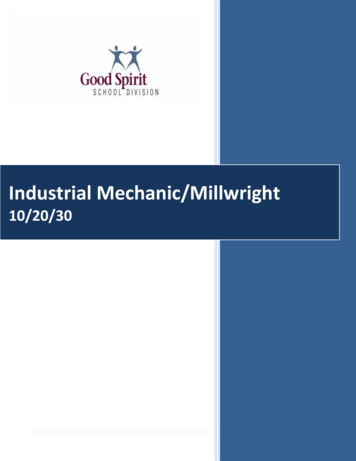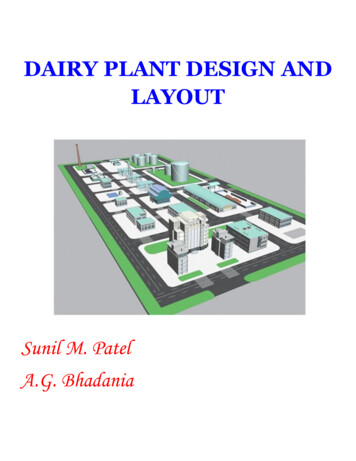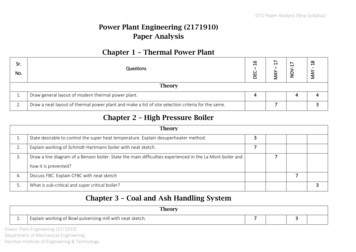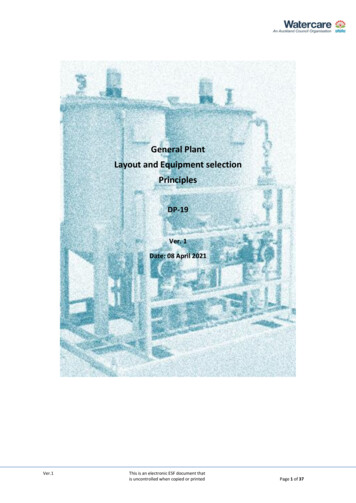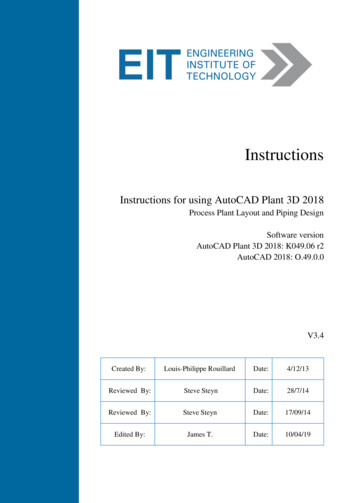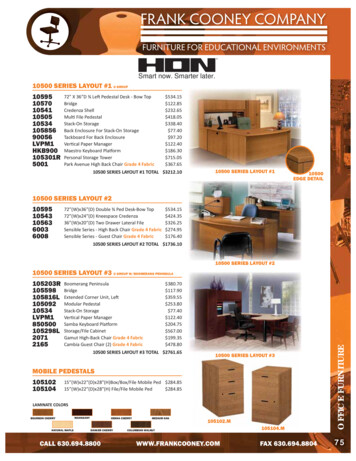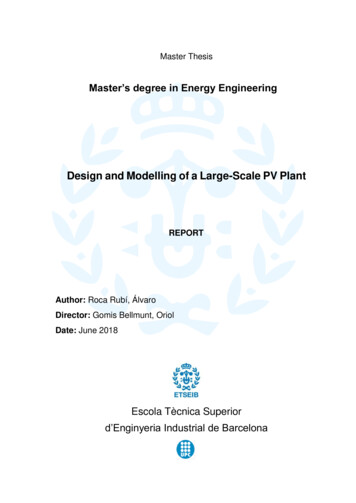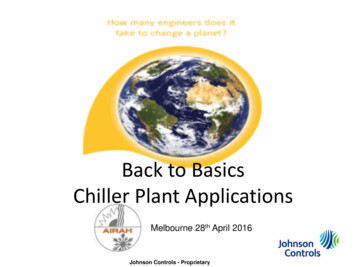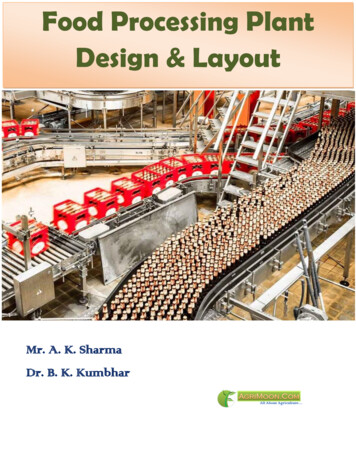
Transcription
Food Processing PlantDesign & LayoutMr. A. K. SharmaDr. B. K. Kumbhar
Food Processing Plant Design & Layout-: Course Content Developed By :Mr. A. K. SharmaAssociate ProfessorCollege of Food Processing Technology and Bio-Energy, AAU-:Content Reviewed by :Dr. B. K. KumbharProfessorDept.of processand food engg.College of technology,GBPUAT,Pantanagar
IndexLessonModule- 1. Introduction of food plant design and layoutLesson 1. Introduction to plant design, situations, differenceand considerationsLesson 2. Food plant design processLesson 3. Introduction to feasibility study and analysisModule- 2. Location and site selection for food plantsLesson 4. Introduction to plant locationModule- 3. Food plant size, utilities and servicesLesson 5. Food plant size and utilitiesLesson 6.Illumination and VentilationModule- 4. Food plant layout Introduction, Planning andExperimentationLesson 7. Plant LayoutLesson 8. Layout Design ProcedureLesson 9. Experimentation in Pilot PlantModule- 5. Symbols used for food plant design and layoutLesson 10. Symbols used for food plant design and layoutLesson 11. Food processing enterpriseModule- 6. Food processing enterprise and engineeringeconomicsLesson 12. Engineering economicsModule- 7. Process scheduling and operationLesson 13 Process scheduleLesson 14: Plant operationModule 8. Building materials and constructionLesson 15. Building materialsLesson16. Building constructionPage 71-8081-8384-8687-9798-110111-128
************This Book Download From e-course of ICARVisit for Other Agriculture books, News,Recruitment, Information, and Events atwww.agrimoon.comGive FeedBack & Suggestion at info@agrimoon.comSend a Massage for daily Update of Agriculture on WhatsApp 91-7900 900 676Disclaimer:The information on this website does not warrant or assume any legalliability or responsibility for the accuracy, completeness or usefulness of thecourseware contents.The contents are provided free for noncommercial purpose such as teaching,training, research, extension and self learning.****** ******Connect With Us:
Food Processing Plant Design & layoutModule- 1. Introduction of food plant design and layoutLesson 1. Introduction to plant design, situations, difference and considerations1.1 IntroductionThe manufacturing of food products of consistent quality and nutritional value ataffordable cost is essential to the success of the food industry today. The efficient use ofresources is, therefore, growing concern for all involved in handling of raw materials andenergy for processing, production, distribution and retailing of food. The unique features ofthe raw materials of the food processing industries such as seasonality, perishability andvariability in conjunction with sophistication required for processing to maintain highquality standards, necessitates special attention towards skilled technical manpower,effective technologies, efficient machinery in the food plant.Plant design refers to the overall design of a manufacturing enterprise / facility. It movesthrough several stages before it is completed. The stages involved are: identification andselection of the product to be manufactured, feasibility analysis and appraisal, design,economic evaluation, design report preparation, procurement of materials including plantand machinery, construction, installation and commissioning. The design should considerthe technical and economic factors, various unit operations involved, existing and potentialmarket conditions etc.1.2 Plant design specifies Flow charts and plant layouts spell out interconnections and raw material flows,permanent/temporary storage, shop facilities, office spaces, delivery and shippingfacilities, access ways Equipments, utilities and services to be used Required instrumentation and interconnections for process monitoring and controls Strategic site location, plan and elevationThey also often provide economic analyses of plant profitability in terms of various productdemand and price and material cost scenarios.Plant design situations may arise due to one or more of the following: design and erection of a completely new plant design and erection of an addition to the existing plant the facility or plant operations and subsequent expansion restricted by a poor site, thereby necessitating the setting up of the plant at a new site addition of some new product to the existing range5www.AgriMoon.com
Food Processing Plant Design & layout adoption of some new process /replacement of some existing equipment modernization / automation of the existing facility expansion of the plant capacity relocating the existing plant at a new site because of new economic, social, legal orpolitical factors1.3 Differences in the design of food processing and non-food processing plantsMany of the elements of plant design are the same for food plants as they are for otherplants particularly those processing industrial chemicals. However, there are manysignificant differences, basically in the areas of equipment selection and sizing, and inworking space design. These differences stem from the ways in which the processing offoods differs from the processing of industrial chemicals. Such differences occur because ofthe following considerations: The storage life of foods is relatively limited and strongly affected by temperature,pH, water activity, maturity, prior history, and initial microbial contamination levels. Very high and verifiable levels of product safety and sterility have to be provided. Foods are highly susceptible to microbial attack and insect and rodent infestation. Fermentations are used in producing various foods and bio chemicals. Successfulprocessing requires the use of conditions, which ensure the dominance of desiredstrains of microorganisms growth or activity. Enzyme-catalyzed processes are used or occur in many cases. These, like microbialgrowth and fermentation are very sensitive to temperature, pH, water activity andother environmental conditions. Many foods are still living organisms or bio chemically active long after harvest orslaughter. In some cases foods (e.g. ripening cheeses) contain active living micro organisms,which induce chemical transformations for long periods of time. Crop-based food raw materials may only be available in usable form on a seasonalbasis. Therefore, plant design may involve the modelling of crop availability. Food raw materials are highly variable and that variability is enhanced by the ageingof raw material and uncontrollable variations in climatic conditions. The biological and cellular nature and structural complexity of foods causes specialheat-transfer, mass-transfer and component separation problems. Foods are frequently solid. Heat and mass-transfer problems in solids have to becreated in ways that are different than those used for liquid and gas streams. Thekinetics of microbe and enzyme inactivation during thermally induced sterilizationand blanching and heat-transfer in the solids being sterilized or blanched arestrongly linked.6www.AgriMoon.com
Food Processing Plant Design & layout Food processing generates wastes with high BOD loads. Foods are often chemically complex systems whose components tend to react withone another. Certain types of reactions, e.g. Maillard reactions, oxidativerancidification, hydrolytic rancidification and enzymatic browning tend to occurwith a high degree of frequency. The engineering properties of foods and biological material are less well known andmore variable than those of pure chemicals and simple mixtures of chemicals. Vaguely defined sensory attributes often have to be preserved, generated ormodified. These require sensory testing. Raw material variation, minor processingchanges and trace contaminants leached from processing equipment and packagescan often cause significant changes in these attributes. Frequently, we do not havemechanistic bases for linking these attributes to processing conditions andequipment design. Much current food engineering and food science research activityat universities is designed to provide such linkages. In the case of foods, prototype products have to be consumer tested so as to assuremarket acceptability before plants for large scale production are built. Mechanical working is sometimes used to induce desired textural changes. Examplesinclude kneading and sponge mixing during the making of bread, the calendaring ofpastry dough, shearing during extrusion texturization. Packaging in small containers is often used or required; and strong-package-productinteractions exist. Packaging often requires care to maintain integrity of closure,reproducibility of fill elimination of air from head spaces and prevention ofsubsequent moisture and oxygen transfer. Segregation often causes problems in thepackaging of powdered foods. Aseptic packaging is starting to be widely used. Food processing techniques and formulations are sometimes constrained bystandards of identity and good manufacturing practice regulations and codes. Food processing is an art to a certain extent. Engineers and technologists arefrequently uncertain as to weather portions of that art are really justified ornecessary. It is sometimes difficult for them to translate the necessary portions ofthat art into quantifiable heat-transfer and chemical reaction processes on whichrational designs can be based.1.4 General design considerationsFood plant designs must provide necessary levels of sanitation, means of preventingproduct and material contamination and means of preventing or limiting product, rawmaterial, and intermediate product deterioration due to naturally occurring processes.Great care must be exercised to achieve high levels of product purity and preserve productintegrity. A brief description of some of the design considerations follows.1.4.1 Food processing unit operationsFood processing involves many conventional unit operations but it also involves manywhich differ greatly from those usually encountered in the production of industrialchemicals. These include: freezing and thawing and other temperature-induced phase7www.AgriMoon.com
Food Processing Plant Design & layouttransitions or phase transition analogs, freeze drying, freeze concentration, curd and gelformation, development of structured gels, cleaning and washing (the operation whichoccurs with the greatest frequency in food processing plants), leavening, puffing, andfoaming, slaughtering, carcass disassembly, component excision, slicing and dicing, peelingand trimming, grading, cell disruption and maceration, pasteurization and sterilization,blanching, baking, cooking (for purposes of tenderization or textural modification), roasting(for purposes of flavour generation), radiation sterilization, mechanical expression,structure-based component separation, filling and packaging, canning and bottling, coatingand encapsulation, sausage and flexible casing, stuffing, controlled atmosphere storage,fumigation and smoking, churning, artificially induced ripening, fermentation, pureeing,emulsification and homogenization, biological waste treatment, and controlled feeding ofconfined animals, poultry and fish.1.4.2 Prevention of contaminationPrevention of contamination will involve the provision or use of filtered air, air locks,piping layouts that ensure complete drainage and present cross-stream contamination(particularly contamination of finished products by unsterilized or unpasteurized rawmaterial and cleaning solutions), solid material and human traffic flow layouts that alsoprevent such contamination, suitably high curbs when pipes, conveyors or equipment passthrough floors and where gangways pass over processing areas, bactericides in coolingwater, culinary (i.e. contaminant-free) steam whenever direct contact between a productand steam is used, impermeable covers for insulation, dust covers over conveyors and clearplastic covers for electric lights, methods for washing bottles and containers, suitablebarriers against pest entry, windowless construction, solid instead of hollow walls, orcompletely tight enclosure of hollow spaces in walls, air circulation system and externalroof and wall insulation that prevent the formation of condensate which can drip intoproducts or favour mould growth, ultra-violet irradiation of tank head spaces, electric lighttraps for flying insects, impactors for killing insect eggs, larvae, pupae and adults in grain,carbon dioxide and nitrogen fumigation of dry food storage bins, screening system toremove insects and insect parts, magnetic traps, iron screens for sieving equipment (so thatscreen fragments can be picked up by magnetic traps), metal detectors for rejectingpackaged product that contains unwanted metal, and methods for storing and keepingtrack of segregated batches of raw materials and finished goods until necessary qualityassurance tests have been carried out.1.4.3 SanitationSanitation, which helps prevent contamination, should be facilitated by providing or using:impermeable coated or tiled floors and walls, at least one floor drain per every 40 m 2 of wetprocessing area, special traps for such drains, pitched floors that ensure good drainage,polished vessels and equipment that do not contain dead spaces and which can be drainedand automatically cleaned in place, sanitary piping, clean-in-place (CIP) systems, plate heatexchangers and other types of equipment which can be readily disassembled for cleaning ifnecessary, clearances for cleaning under and around equipment, grouting to eliminatecrevices at the base of equipment support posts and building columns, tubular pedestalsinstead of support posts constructed from beams, and methods for removing solid particleswhich fall off conveyors. Air flow and human traffic flow patterns should be maintained toeliminate possibilities of containment transfer from dirty areas to clean ones. Very highlevels of sanitation must be provided for foodstuffs that provide good substrates for thegrowth of micro organisms and when processing temperatures and conditions favour suchgrowth.8www.AgriMoon.com
Food Processing Plant Design & layout1.4.4 DeteriorationTo minimize product and raw material deterioration, provisions should be made for:refrigerated and controlled environment storage areas, space and facilities for productinspection and for carrying out quality assurance tests, surge vessels for processed materialbetween different operations (particularly operations which are subject to breakdown),equipment for pre-cooling material stored in such vessels, means of cooling, turning over orrapidly discharging the contents of bins and silos when excessive temperature rises, occur,and standby refrigeration and utility arrangements which are adequate to prevent productand raw material deterioration in case of power interruptions or unusual climaticconditions.1.4.5 Seasonal productionFood plants have to be sized to accommodate peak seasonal flows of product withoutexcessive delay, and in some cases, have to be highly flexible so as to handle different typesof fruits and vegetables. Modelling of crop and animal growth processes can be of greathelp in scheduling production and adequately sizing plants.9www.AgriMoon.com
Food Processing Plant Design & layoutLesson 2. Food plant design process2.1 IntroductionThe design process on all projects follows the same stages of development. However theextent and detail of the activities behind each stage are different with every project.Thereare a number of different industry formats for mapping the stages in the engineeringprocess. A sequence that provides a simple fit with plant design activities is outlined inFigure 2.1. This is based on the overall project involve estimation of plant and/orequipment/s capacity, process scheduling and proper layout so as to meet specialrequirements and needs to be focused on theses. The following are the few aspects thatmake the food industry as a unique.2.2 Feasibility studyThe basis for the success of the design of any food processing plant is a comprehensivefeasibility study and evaluation. The feasibility study involves an analysis and evaluationof the design concept from all the relevant angles. The study provides an immediateindication of the probable success of the enterprise and also shows what additionalinformation is necessary to make a complete evaluation. It gives an insight in to:requirements of human, financial and material resources; plant and machinery, technology;and economic gains or profitability of the proposed venture.The feasibility analysis involves a certain number of stages during which various elementsof the plant design are prepared and examined to arrive at appropriate decision. Thefeasibility study can, therefore, be seen as a series of activities culminating in theestablishment of a certain number of study elements and documents, which permit decisionmaking. Identification stages, preliminary selection stage, analysis stage and evaluation anddecision stage are the important stages.2.3 Project idea2.3.1 Identification stage:Once a product idea occurs, the starting point of analysis is the establishment of theobjectives to be attained. The objective may be to prove that it is possible and desirable tomanufacture a certain product or group of products, to add a piece of equipment to theexisting plant or to utilize certain resources.The ideas for new products or diversification can be generated in an informal andspontaneous manner from customers, distributors, competitors, sales people, and others, orthe entrepreneur can rely on a systematic process of idea generation.Two key approaches for product identification and selection could be:a) Look for a need and then the product to satisfy that need, orb) Find a product idea and then determine the extent of the need.10www.AgriMoon.com
Food Processing Plant Design & layout2.3.1.1 Looking for a need:Venture ideas can be stimulated by information which indicates possible need. Thisapproach requires access to data and considerable analysis. However, if the perceived needis real, the product idea has a better than average chance of leading to a successful venture.The need may be one now being served inefficiently at high cost, or it may be presentlyunserved. The second implies that a considerable amount of creative design anddevelopment may be required to arrive at a product that appears to satisfy the need. Thefollowing is suggested for identification of the need. Study existing industries for backward and forward product integration to indicateinput and output needs Analyse population trends and demographic data for their affect on the market Study development plans and consult development agencies for development needsand venture opportunities. Examine economic trends in relation to new market needs and opportunities. Analyse social changes study the effects of new legislations in relation to creation of new opportunities2.3.1.2 Finding a product:Each of the preceding suggestions for idea generation centres on the recognition of a needin order to arrive at a product idea. The suggestions that follow are product oriented. Theyare intended to stimulate product ideas which may meet one or more of the criteriapreviously discussed. Their use should result in a large number of ideas which can besubsequently examined with regard to need. The following list should be useful inconducting such an exercise. investigate local materials and other resources for their current utilization pattern,utilization potential and convertibility into more value added products examine import substitutions for indigenous production study local skills for production and marketing of value added products study implications of new technologies for improvement of existing products or tocreate / produce new ones study and analyze published sources of ideas2.4 Preliminary screening of ideas:By following the above approaches, it should be possible to develop a long list of potentialventure opportunities. Obviously, it would not be realistic to conduct a detailed feasibilityanalysis for each idea. What is needed is a preliminary screening to eliminate the manyideas that have little or no hope for success and to provide, if possible, a rank-ordering ofthe remaining few. The screening can be conducted as two-phase process. In the first phaseventure ideas are eliminated on a go/no-go basis. A "Yes" response to any of the followingshould eliminate the idea from further consideration.11www.AgriMoon.com
Food Processing Plant Design & layout Are the capital requirements excessive? Are environmental effects contrary to Government regulations? Is venture idea inconsistent with national policies, goals and restrictions? Willeffective marketing need expensive sales and distribution system? Are there restrictions, monopolies, shortages, or other causes that make any factor ofproduction unavailable at reasonable cost?2.5 Comparative rating of product ideasAfter elimination of unattractive venture ideas, it is desirable to choose the best of thoseremaining for further analysis. Various comparative schemes have been proposed for ratingventure ideas. In this section, factors that should be considered and some possible rankingmethods are examined. For a product idea to lead to a successful venture, it must meet thefollowing four requirements:a)An adequate present market for raw and finished product/sb)Market growth potentialc)Competitive costs of production and distributiond)Low risk in factors related to demand, price, and costs2.5.1. Present market: The size of the presently available market must provide the prospectof immediate raw material purchase and product/s sales volume to support the operation.Sales estimates should not be based solely on an estimate of the number of potentialcustomers and their expected individual capacity to consume. Some factors that effect salesare: Market size (number of potential customers) Product's relation to need Quality-price relationship compared to competitive products Availability of sales and distribution systems and sales efforts required Export possibilities2.5.2. Market Growth Potential: There should be a prospect for rapid growth and highreturn on invested capital. Some indicators are: Projected increase in need and number of potential customers Increase in customer acceptance Product newness Social, political and economic trends (favourable for increasing consumption)12www.AgriMoon.com
Food Processing Plant Design & layout2.5.3. Competitive costs of production and distribution: The costs of production factorsand distribution must permit an acceptable profit when the product is priced competitively.The comparative rating process should consider factor likely to result in costs higher thanthose of competitive producers should: Costs of raw material inputs Labour costs Selling and distribution costs Efficiency of production processes Patents and licenses2.5.4. Risks involved: Obviously it is impossible to look into the future with certainty, andthe willingness to assume risk is the major characteristic that sets the entrepreneur apart.However, unnecessary risk is foolhardy and, while it may be difficult or impossible topredict the future, one can examine, with considerable confidence, the possible effect ofunfavourable future events on each of venture ideas. The following factors should beconsidered. Market stability in economic cycles Technological risks Import competition Size and power of competitors Quality and reliability risks (unproven design) Initial investment cost Predictability of demand Vulnerability of inputs (supply and price) Legislation and controls Time required to show profit Inventory requirementsFor purposes of preliminary screening, these factors can be subjectively evaluated.13www.AgriMoon.com
Food Processing Plant Design & layoutLesson 3. Introduction to feasibility study and analysis3.1 Pre selection/Pre-feasibility stageThe preliminary screening may have several ideas which appear to be worthy of furtherstudy. Since a complete feasibility study is time consuming and expensive, it may bedesirable to perform a pre-feasibility analysis in order to further screen the possible ideas.The purpose of a pre-feasibility study is to determine. Whether the project seems to justify detailed study What matters deserve special attention in the detailed study (e.g. market analysis,technical feasibility, investment costs) An estimate of cost for the detailed studyFor many ideas the pre-feasibility analysis may provide adequate evidence of ventureprofitability if certain segments are more carefully verified. Emphasis depends on thenature of the product and the area of greatest doubt. In most cases market aspects andmaterials receive primary emphasis. The pre-feasibility study and report may include someor all of the following elements.3.1.1 Product description: The product's characteristics should be briefly described, alongwith possible substitutes which exist in the market place. Also, allied products should beidentified, which can or should be manufactured with the product under study.3.1.2 Description of market: The present and projected potential market and thecompetitive nature of the market should be delineated. Where is the product now manufactured? How many plants exist and how specialized are they? What are the national production, imports, and exports? Are there government contracts or incentives? What is the estimated product longevity or future consumption? What is the price structure?3.1.3 Outline of technological variants: The technology choices that exist for themanufacture of the product should be described briefly. Also, the key plant location factorsshould be identified.3.1.4 Availability of main production factors: Production factors such as raw materials,water, power, fuel and labor skills should be examined to ensure availability.14www.AgriMoon.com
Food Processing Plant Design & layout3.1.5 Cost estimates: Estimates should be made of the necessary investment costs and costsof operation.3.1.6 Estimate of profit: The data gathered should include estimates of profits of firmsmanufacturing similar products or, if the preliminary data are extensive, an actualestimated profit for the project under study.3.1.7 Other data: In certain cases, local attitudes toward industry; educational, recreationaland civic data; and availability of local sites, may be the most important in the evaluation ofthe suitability of a proposed product, especially in the case of the establishment of a newfirm.Thus pre-feasibility study can be viewed as a series of steps culminating in a documentwhich permits determination of whether or not a complete detailed feasibility study shouldbe made. It does not possess the depth the detailed study is expected to have, and the datausually are gathered in an informal manner.3.2 Analysis stageAt the analysis stage various alternatives in marketing, technology and capital availabilityneed to be studied. The analysis can be conducted at different levels of effort with respect totime, budget and personnel, depending on the circumstances. The complete study isreferred to as techno-economic feasibility study. In some cases such a detailed study is notnecessary. For example, if the product has an assured market, in-depth market analysis isnot required. In some cases, a partial study of the market or of the technologies satisfies thedata requirements for decision making. The detailed analysis should include the following.3.2.1 Market analysis / study:Market analysis can serve as a tool for screening venture ideas and also as a means ofevaluating the feasibility of a venture idea in terms of the market. It provides: understanding of the market information on feasibility of marketing the product analytical approach to the decision makingIn addition, it assists in analyzing the decisions already taken. Market analysis answersquestions about: size of market and share anticipated for the product in terms of volume and value pattern of demand market structure buying habits and motives of buyers past and future trends price which will ensure acceptance in the market most efficient distribution channels,15www.AgriMoon.com
Food Processing Plant Design & layout company's strong points in marketingMarket analysis involves systematic collection, recording, analysis, and interpretation ofinformation on: existing and potential markets marketing strategies and tactics interaction between market and product marketing methods current or potential productsIn collecting the market data, for whatever size market or type of product, it is helpful tofollow an orderly procedure.The initial step is to put down in writing a preliminary statement of objectives in as muchdetail as possible. A good procedure is to structure the objectives in question form. Whensetting objectives, always keep in mind as to how the information will be used when it isobtained. This helps in eliminating objectives that would not make a contribution to themarket analysis.3.2.2 Situational analysis related to market:The situational analysis of the market involves analyzing the product's relationship to itsmarket by using readily available information. The information reviewed and eachquestion asked will give the analyst a feel for the situation surrounding the product. Thestate involves an informal investigation which includes talking to people in wholesalemarket, brokers, competitors, customers and other individuals in the industry. If thisinformal investigation produces the sufficient data to measure the market adequately, theanalysis need not proceed further. Also, in some instances, where time is critical or wherebudget is a problem, the data gathered during the informal market analysis may be all thatis available on which to base decisions.Seldom do the data obtained during
Plant design refers to the overall design of a manufacturing enterprise / facility. It moves through several stages before it is completed. The stages involved are: identification and selection of the product to be manufactured, feasibility analysis and appraisal, design, economic evaluation, design

